The Traditional Art of Beauty and Perfume in Ancient Korea {Cultural Notes} {Beauty Notes}
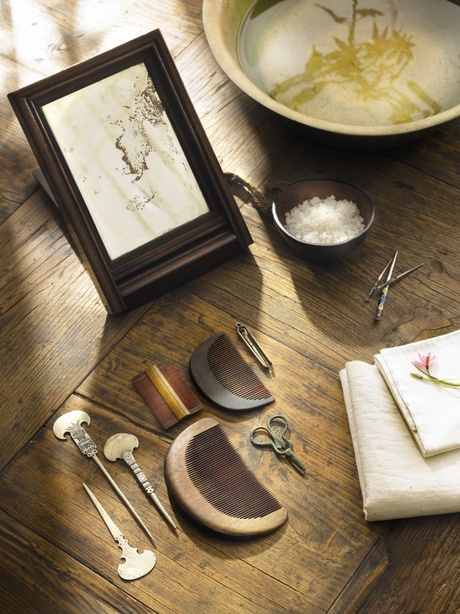
Fig. 1 - Beauty set: hair pins, combs, tweezer © Coreana Cosmetics Museum
The Traditional Art of Beauty and Perfume in Ancient Korea by Guest Contributor Pauline
In keeping with my enthusiasm for cosmetics that make use of organic and natural ingredients, I thought that it would be interesting to explore the traditional Korean art of beauty and cosmetological culture in ancient times; more particularly as it was experienced from the medieval period until the turn of the 20th century.
If this topic may appear a bit nerdy at first blush, I can point out that nowadays mainstream contemporary beauty brands do not hesitate to use ancient medieval recipes like, for instance, Lush with its "Angels on Bare Skin" facial scrub and Caudalie with its "Eau de Beauté" based on the legendary rejuvenating rosemary lotion called "Eau de la Reine de Hongrie" dating back to the European Middle Ages.
I love Asian art, often travel in the region and so I was delighted to discover this tradition, which as it turns out, emphasized the use of gentle natural ingredients - flowers, fruit kernels, beans - rather than chemical concoctions such as the infamous Blanc de Céruse composed of white lead which ailed and disfigured many a beauty junkie's face in modern Europe. This is not however to say that chemicals are not sometimes beneficial - or that natural ingredients are always the best alternatives.
An exhibition organized by the Coreana Cosmetics Museum entitled Parures, fards et onguents dans la Corée ancienne (Adornments, Make-up, and Oinments in Ancient Korea) was held last year in Paris on this virtually unknown topic in Europe - and even the West at large...
Fig. 2 - An 18th century Korean beauty. Attributed to Kim Hong-Do (A.D. 1745- ?) © Seoul National University Museum.
Fig 3. - Celadon cosmetics containers, Koryo period (A.D. 918-1392) © Coreana Cosmetics Museum
Fig. 4 - Rouge container in white and blue porcelain, Choson period (A.D. 1392-1910) © Coreana Cosmetics Museum
Fig. 5 - Powder dish, Choson period © Coreana Cosmetics Museum
Fig. 6 - Water-dropper for preparing make-up, Choson period © Coreana Cosmetics Museum
The selection of cosmetics containers (fig. 3, and figs. 4-6), make-up tools, hair accessories and jewels which were exhibited - reproduced here with kind permission - come from the Coreana Cosmetics Museum, an affiliate of the Coreana Cosmetics Company, which is currently one of the largest beauty companies in South Korea.
The private museum was established in Seoul in 2001 by Yu Sang-ok, the founder and owner of the company. It currently holds the largest collection of artefacts related to the history of Korean cosmetic and beauty culture, including 5 300 objects, ranging from the Three Kingdoms period (57 B.C. -A.D. 668) to the early 20th century. These objects were assembled with great care and passion by Mr. Yu.
Feminine Beauty Criteria and Ideals
Thick glossy hair, a fair skin, thin eyebrows, and small lips (Korean beauties of the time would probably shudder with horror at the thought of getting silicone injections today) constituted the classical canon of beauty in medieval Korea (see fig. 2).
The woman depicted in this 18th century painting by Kim Hong-Do actually wears a wig made of coiled braids which was the most common style of hairdo at that time. The frenzy for this accessory was such that in 1788 King Chongjo prohibited by royal decree the use of such extravagant wigs, which were deemed contrary to Confucian values of reserve and restraint.
It is interesting to note on an anthropological level that comparable towering hairdos, which were equally status-affirming, were also popular at the French court at Versailles in the 18th century.
The twelfth century source, the Illustrated Record of the Chinese Embassy to the Koryo Court (A.D. 1123) by the Chinese envoy from the Northern Song court, Xu Jing (A.D. 1091-1153) informs us about the make-up styles of Korean women from the upper classes during the Koryo period (A.D. 918-1392).
It is recorded that they favored applying light make-up, using powder - but without rouge or blush - and drew eyebrows in the shape of a "willow leaf".
The Kyuhapch'ongso, dated from 1809, which was an instructional guide for everyday life for women of the social elite during the late Choson period, covering more than five centuries (A.D.1392-1910), records various techniques of manufacturing cosmetic products and fragrances such as rouge for the cheeks and lips, fragrances to perfume the body, oils to maintain long, black, glossy hair - as well as the descriptions of the shapes of eyebrows; up to ten different ones.
Fig.7 - Celadon cosmetics oil bottle, Koryo period © Coreana Cosmetics Museum
The Making of Cosmetics and Perfume
Facial scrubs were made with ginseng root, red bean, green mung bean, or sponge gourd, while facial lotions were made of cucumber or watermelon juices, and perfumed with scented plants.
Sunflower seeds, cabbage seeds and castor-oil plant were often used to produce cosmetic oils; peony flower oil was particularly favored by Korean noblewomen of the 19th century to make their hair sleek - an ideal of beauty.
Owing to the lack of preservatives in ancient times, make-up was made in small quantities corresponding to daily needs and kept in tiny containers with a narrow aperture to prevent alteration, such as demonstrated with the Celadon cosmetics oil bottle shown here (fig. 7).
The blue and white cosmetic set presented above (figs. 4-6) consists of a small pot which used to contain rouge, an octagonal dish for preparing make-up and a mini-water dropper used to dilute cosmetics. I marveled to see that these containers are only between one to one and half inches high!
Small pouches filled with fragrant herbs or scented with lightly diluted natural musk were carried both by men and women. In fact, court officials at the king's service were required to carry such perfumed pouches during the Koryo period (A.D. 918-1392).
Historical records mention the existence at the royal court of artisan-perfumers called "Hyangjang" who bred musk deers in the palace precincts to produce perfume and incense. Clove, star anise and "nut grass" were the main ingredients used in producing perfumes.
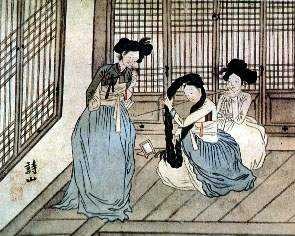
Kisaeng women, by Yu Un-hong (1797-1859)
Styles of Makeup
A simple yet elegant appearance associated with a dignified demeanour and humble manners, were considered the epitome of beauty and elegance following Confucian ideals of the Choson period. While women from the upper classes could afford to use a higher-quality mixture of flower ashes, indigo plants and real gold powder to produce the dye for the eyebrow or the rouge make-up made of saffron flowers and cinnabar, less affluent people would use a piece of charcoal to highlight their eyebrows as well as dried red pepper as a substitute for rouge.
A white-powdered face was to be avoided at all cost since it was the makeup style of the lowly lives like the female entertainer or Kisaeng (the Korean equivalent of the Japanese Geisha). They were women trained in the art of music, dance and poetry (fig. 8).
Respectable women were expected to wear light-peach-colored make-up when going out or receiving guests.
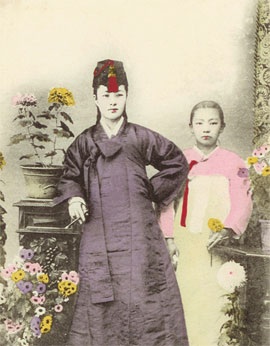
A postcard used by a French missionary in 1910. The caption reads, "A Corean Singer & Maid"; The first was identified as a Kisaeng, from Chosun
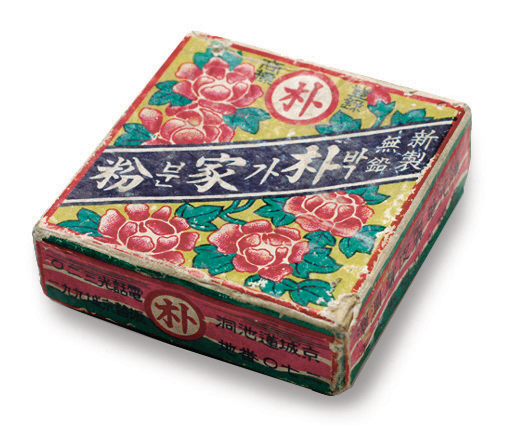
Fig. 8 - Pak's Powder, the first Korean beauty product to be manufactured in the country, 1916 © Coreana Cosmetics Museum.
New make-up styles and cosmetics were introduced in Korea in the late 19th century following the Treaty of Kanghwa in 1876 when Korean ports opened to foreign trade. European cosmetics, in particular French brands, were imported starting in the early 20th century. They were so popular that they created the impetus for the creation in 1916 of the first face powder ever manufactured in Korea, Pak's powder. Its release marked the advent of a modern, industrial age for beauty in Korea.
Added in 2013:
Today, the beauty industry in Korea is vibrant and has even gone global, in particular with the now widespread popularity of a product which was local initially, the BB cream.
The famous kisaeng Hwang Jin-I played by South Korean actress Ha Ji-Won in a TV drama, from Chosun
Acknowledgment: I wish to thank the Coreana Cosmetics Museum for providing information included in this article, as well as the pictures illustrating this post.
Pictures © All rights reserved by the Coreana Cosmetics Museum, except where mentioned otherwise.







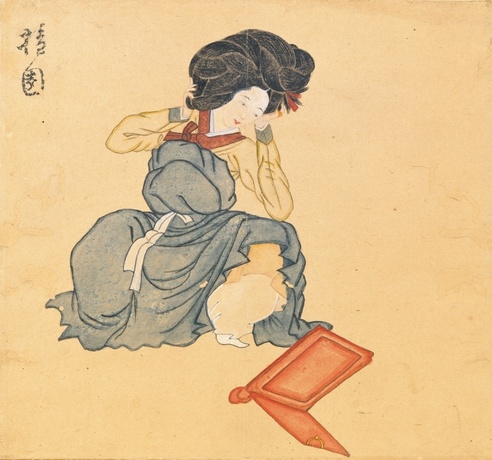
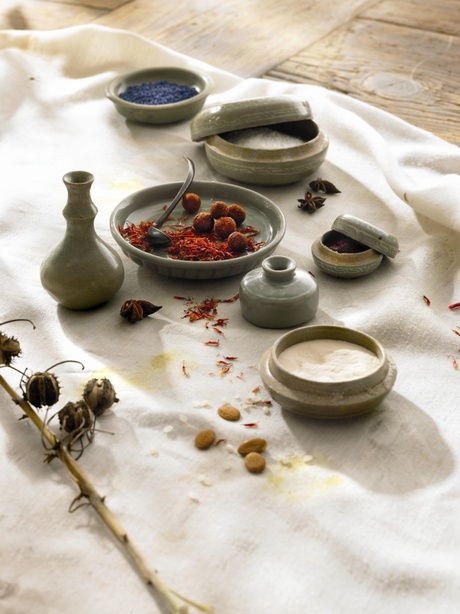
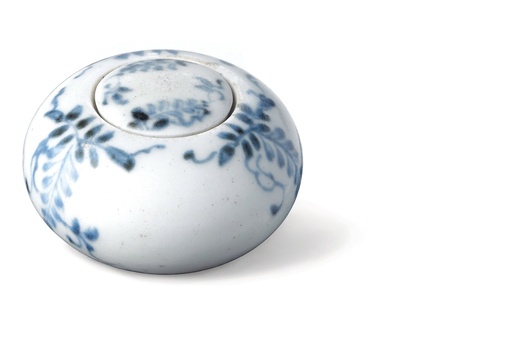
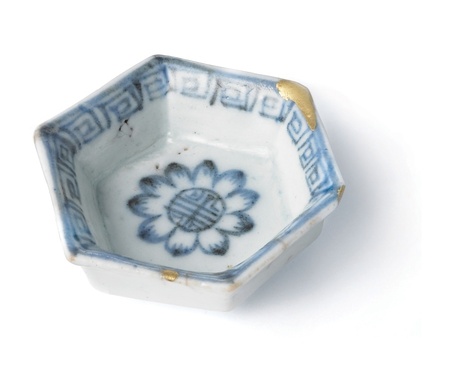
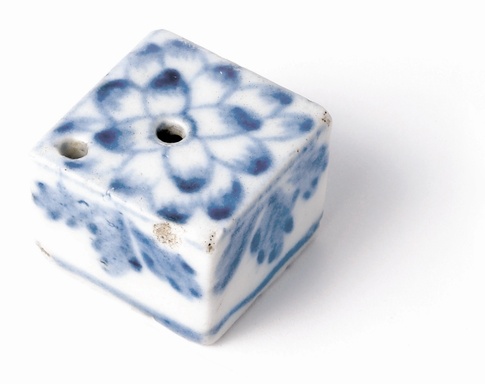
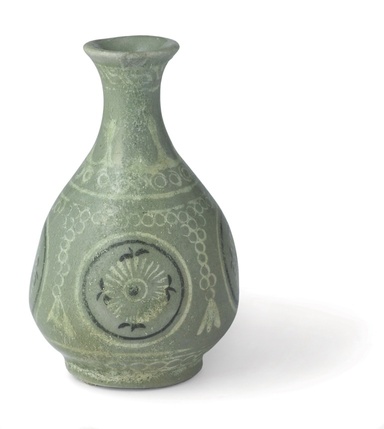
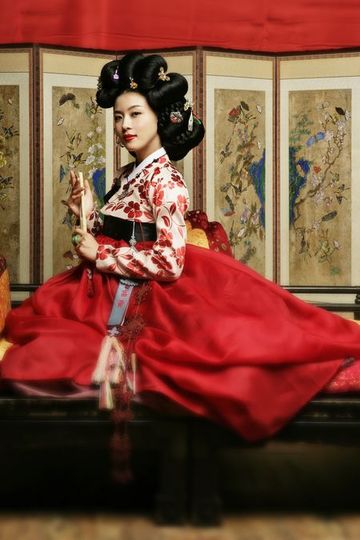

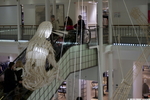
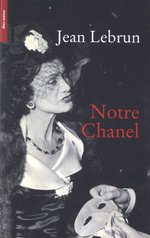
Wonderful photos and great research--good to know there were perfume addicts all over the world and for hundreds of years!
Quinn,
Thank you for your kind comment. I also learned that people in ancient times in Korea would take baths that were infused with orchid or iris, although I cannot say in what century exactly.
Pauline
Hello Pauline,
Nicely presented entry.
Would you be able to contact me offline via the above email? I am doing some research and would like to ask you a few questions about this article.
Thank you.